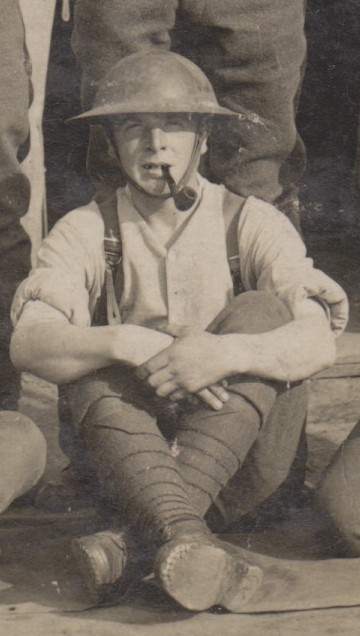
This story was submitted by Mr Johnson of Richmond, he is the grandson of John Ramsden.
John was born in East Ardsley, Leeds. He was called up in 1917 and trained at Chelmsford. He was posted with the 6th Battalion, Durham Light Infantry as 78916 Pte J Ramsden. John kept a diary during his time away from home. On 6th February 1918 at Passchendale Ridge he recorded “Shells are whistling menacingly overhead, I hope my God will give me the strength to withstand the trials that beset me!”
21st March 1918 saw the last big German attempt to win the war. John’s diary reads, “Found a fellow I’ve seen very often laid out of the trench – grim and bloody – ah, yes but smiling in death”.
John was wounded on 28th March and was evacuated to Rouen with other casualties. On 31st March he wrote, “The Doc prodding my head with an instrument much like a pair of sugar tongs. Eventually succeeds in extracting a small piece (but quite big) of the product of Essen”.
After recovering, John was sent back into the line in late May. Again he was hospitalised, this time in an American hospital, taking a serious wound to the hand. The family always believed that the different approach taken by American surgeons saved John’s hand from amputation.
John survived the war and moved to Barnsley, running the local cinema and writing a column for the Barnsley Chronicle.
Explore more memories from the ribbon
-
Maud Florence Hoare
Maud Florence Hoare Maud was living in Ashford in Middlesex when she enrolled as a VAD for the British Red Cross. She joined in January 1915 and was stationed at the Military Hospital Catterick Camp. Maud spent approximately a year at Catterick Camp. Stationed from 15th January 1918 until the 9th of February 1919. This information, provided by Alathea Anderssohn has been drawn from the Imperial War Museum’s ‘Lives of the First World War’ archive.
-
Joseph Stoney
Information from Judith Farrar which relates to her husband Don’s great-uncle. Joseph Stoney’s occupation before the war as a stonemason, a skilled trade which places strenuous demands upon the worker’s hands. This was of some consequence following his attempt to enlist at the start of the First World War. He had previously been a territorial soldier with the West Yorkshire Regiment and when war broke out he naturally offered his services to his former regiment. His record shows that he was accepted, but that after only sixteen days he was discharged. The medical discharge paper records ‘Deformity of both thumbs, rheumatoid arthritis. Loss of gripping power. General debility.’ This judgement is reinforced by a second comment in a second hand, ‘Not likely to become an efficient soldier.’ This judgement did not deter Joseph from trying again, as his medal card attests. He managed to join the 1st Battalion, Yorkshire Regiment as 21581 Private J Stoney and was awarded the British War medal. Unfortunately John died either on the way out to India where the battalion was stationed, or when returning on leave. John died from dysentery on 10 May 1917 and is buried in the Cape Town (Maitland) Cemetery. His headstone appears to record the correct regimental number, but displays the West Yorkshire badge, rather than the Yorkshire Regiment.
-
Cyril and Christopher Fawcett
Paul Goad, a resident of Frenchgate and local history enthusiast submitted his research on one of the families from Frenchgate at the time of the Great War. The Fawcett family lived at 55 Frenchgate, Richmond throughout the First World Ward. John Fawcett, who worked in agriculture and construction, lived here with his wife Elizabeth Grace, daughter Elizabeth Alice and two sons, Christopher and Cyril Edgar. John was born in Castle Bolton in Wensleydale, Elizabeth Grace in Thornton Buckinghamshire and all three children hailed from the small parish of Walburn, Downholme a little way up Swaledale from Richmond. At the outbreak of hostilities Christopher was 20 and Cyril 14. As the eldest, Christopher was the first to enlist on 27th November 2015, three months shy of his 22nd birthday. Prior to enlistment he worked as a butcher, a profession he continued after the war. In January 1916 he joined the 4th Battalion of the Durham Light Infantry. The 4th DLI were a reserve Battalion and were station at Seaham Harbour from 1915 through to the end of the War. Records confirm that Christopher was based at Seaham from 1916 to June 1918 serving in D Company. A copy of a charge sheet shows that Christopher was late returning from leave on June 12th 1916 for which he was forfeited 1 days pay. In October 1917 Cyril enlisted at the age of 18 years and 1 month, giving his trade as a Motor Driver. Despite his Attestation papers suggesting that he was…
